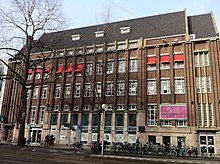Lippmann, Rosenthal & Co.



Lippmann, Rosenthal & Co. or Liro Bank originally a Dutch Jewish bank, was seized and used by Nazis for looting Jewish property during the German occupation of the Netherlands during World War II.[1]
At Nieuwe Spiegelstraat, in Amsterdam, the Germans used the bank's name for a separate branch for looting Jews at the Sarphatistraat.[2]
The branch was used for robbing the Dutch Jews living mainly in Amsterdam of their possessions.[3] Bank accounts at other banks were confiscated, and Jews were also forced to deposit their art collections, jewels etc. at the bank.[4][5] If a Jewish family was deported from its home, its possessions were sold. The money was used for various purposes such as to finance the Westerbork transit camp. High-level Nazis could pick from the art collections. In addition, important artworks were sent to German museums.[6]
After the war, the original bank had lost its good name and was finally taken over by another bank, the Hollandse Koopmansbank.[7][8]
In 2003, a plaque about the Nazi robber bank was unveiled on the building of the ABN Amro Bank in Amsterdam.[9]
See also[edit]
- List of claims for restitution for Nazi-looted art
- Arthur Seyss-Inquart
- The Holocaust in the Netherlands
Further reading[edit]
- The Perpetrators and Their Methods Katejan Mühlmann
- Nazi looting : the plunder of Dutch Jewry during the Second World War
- Reconstructing the Record of Nazi Cultural Plunder: A Survey of the Dispersed Archives of the Einsatzstab Reichsleiter Rosenberg (ERR)
References[edit]
- ^ "Nazi Looting: The Plunder of Dutch Jewry During the Second World War". www.lootedart.com. Retrieved 2022-01-28.
But the heart of this book is Aalder's discussion of the operations of the "Liro" Bank or Robber Bank, which was the central clearinghouse in the Netherlands for the looting of Jewish property. Here the technique of utilizing the Jews' own institutions against them, employed throughout the Third Reich by the Nazis, reached its peak. The Liro Bank was set up in the former premises of the highly respected, Jewish-owned Lippmann Rosenthal Bank which had existed for years in Amsterdam. The new entity was not really a bank but a Nazi government agency specialized in theft.
- ^ De Groene, Liro Roofbank, 10 december 1997
- ^ Aalders, Gerard. (2004). Nazi looting : the plunder of Dutch Jewry during the Second World War. Oxford: Berg. ISBN 1-85973-722-6. OCLC 53223516.
- ^ "Jewish War Claims in The Netherlands: A Case Study - Manfred Gerstenfeld". www.jcpa.org. Retrieved 2021-11-15.
- ^ Boffey, Daniel. "Dutch museums discover 170 artworks stolen by Nazis". www.lootedart.com. Retrieved 2020-12-18.
The palace's investigation into tens of thousands of artworks in the House of Orange's collection brought to light convincing evidence that the owner of the van der Haagen painting, depicting a view of Huis ten Bosch Palace, had been forced to hand it over to a Nazi bank, Lippmann, Rosenthal & Co, in Amsterdam.
- ^ Roet, Avraham. "The Netherlands is still hoarding a massive collection of art looted from Jews by Nazis". Haaretz. Archived from the original on 13 September 2017. Retrieved 2020-12-18.
During the next five years, thousands of paintings were moved from Holland into Germany, most of them having been confiscated or extorted from Jews. A large number of artworks were stolen through an institution that came to be called the Liro Bank. Established by the Germans on the shell of the expropriated Jewish-owned bank Lippmann, Rosenthal and Co., it became the major vehicle for wholesale, but nominally legal theft from the Dutch Jews.
- ^ "Liro | Lippmann, Joodse bank in de Sarphatistraat". www.dedokwerker.nl. Retrieved 2022-01-28.
- ^ "Huis Rosenthal door Isaac Gosschalk | Stichting Historische Interieurs Amsterdam". www.historischeinterieursamsterdam.nl. Retrieved 2022-01-28.
Na de Tweede Wereldoorlog hernam de echte Lippmann en Rosenthal bank haar activiteiten, maar de associatie met de gelijknamige roofbank bleek nadelig te zijn voor de bank. In 1964 werd een nauwe samenwerking met de Hollandse Koopmansbank aangegaan, die in 1974 leidde tot een volledige overname door laatstgenoemde bank.
- ^ "Plaque 'Liro' - Amsterdam - TracesOfWar.com". www.tracesofwar.com. Retrieved 2022-01-28.
External links[edit]
 Media related to Lippmann, Rosenthal & Co. at Wikimedia Commons
Media related to Lippmann, Rosenthal & Co. at Wikimedia Commons
